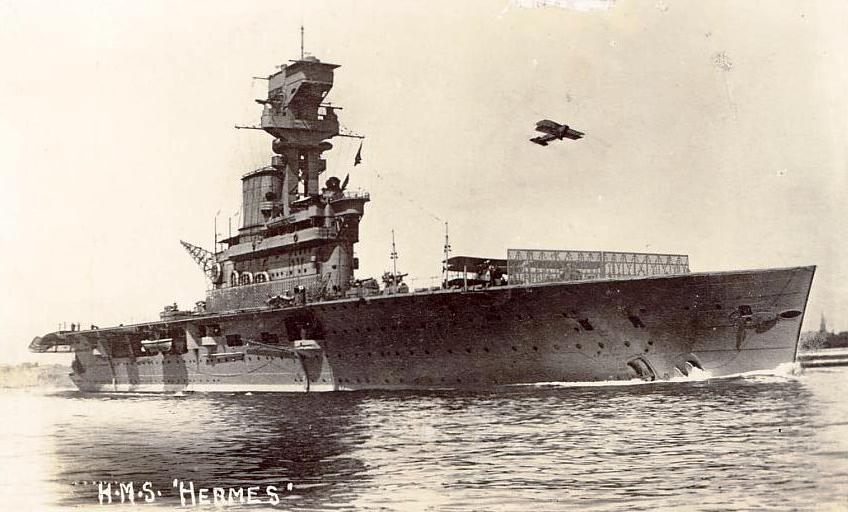HMS
Hermes (D 95) was built by Armstrong (Newcastle-on-Tyne), laid down
15th January 1918, launched 11th September 1919 and commissioned
7th July 1923. She was sunk by Japanese aircraft, off Ceylon, 9th
April 1942.
HMS
Hermes was the first purpose-designed aircraft carrier built for
the Royal Navy and fitted with an off-centre island containing the
funnel and operations spaces. Although very narrow, the island was
quite long and massive for a ship this size. The island located
forward of amidships made the ship trim by the bow, the weight of
the off-set island also caused a list to starboard. This imbalance
had to be corrected by carrying more water ballast and fuel oil
in the port side and aft tanks than in the starboard side and forward
tanks. It was a time of trial and error. The basic hull had been
built along the lines of a light cruiser.
From
1920 until 1938 Hermes served mainly on the China Station. During
1928 and again in 1934 she received refits at Chatham.
During
World War II she served briefly with the Home Fleet before being
assigned to the southern Atlantic from October 1939. She worked
with the French navy based at Dakar until the Vichy government came
to power, following that her aircraft took part in a strike against
the French vessels at Dakar. In July 1940 she collided with a merchant
vessel and was repaired at Simonstown, South Africa. Following repairs
she continued patrols but this time in the Indian Ocean as part
of the Eastern Fleet.
During
the Indian Ocean raid, Hermes was in harbour at Trincomalee, Ceylon,
undergoing repairs. Advance warning of a Japanese air raid allowed
her to leave port, but as she returned following the raid on April
9, 1942, she was spotted off Batticaloa by a Japanese reconnaissance
plane. Lacking planes of her own, she was defenceless when she was
attacked by 70 Japanese bombers. Hit 40 times, Hermes sank with
the loss of 307 men.
Her
escorts — the destroyer HMAS Vampire and the corvette Hollyhock
— and two tankers were also sunk. 590 survivors of the attack
were picked up by the hospital ship Vita and taken to Colombo. Some
survivors were taken to Kandy where they spent 10 days recuperating
at the Queens Hotel.
For
more information see uboat.net
- HMS Hermes
